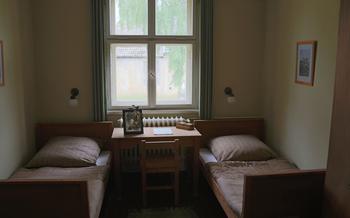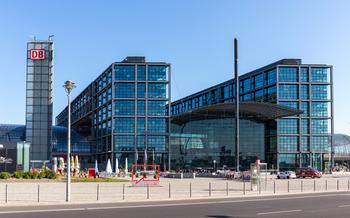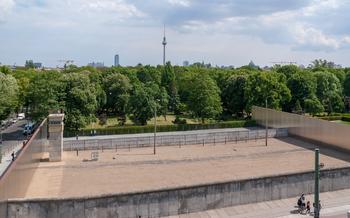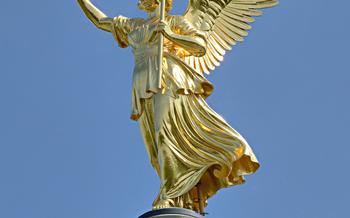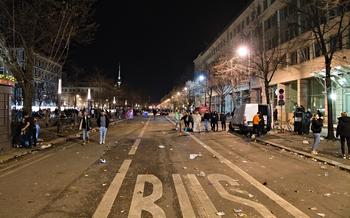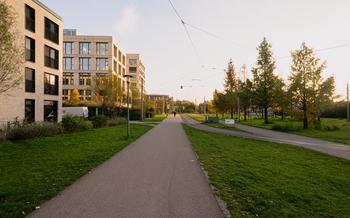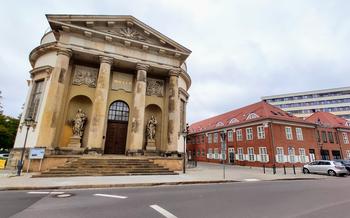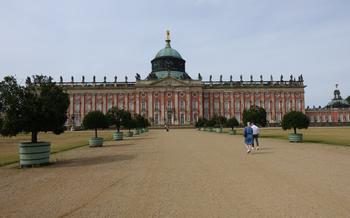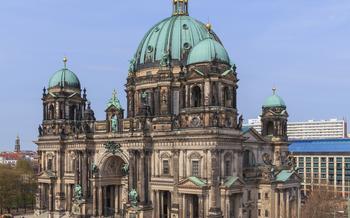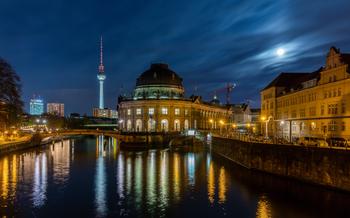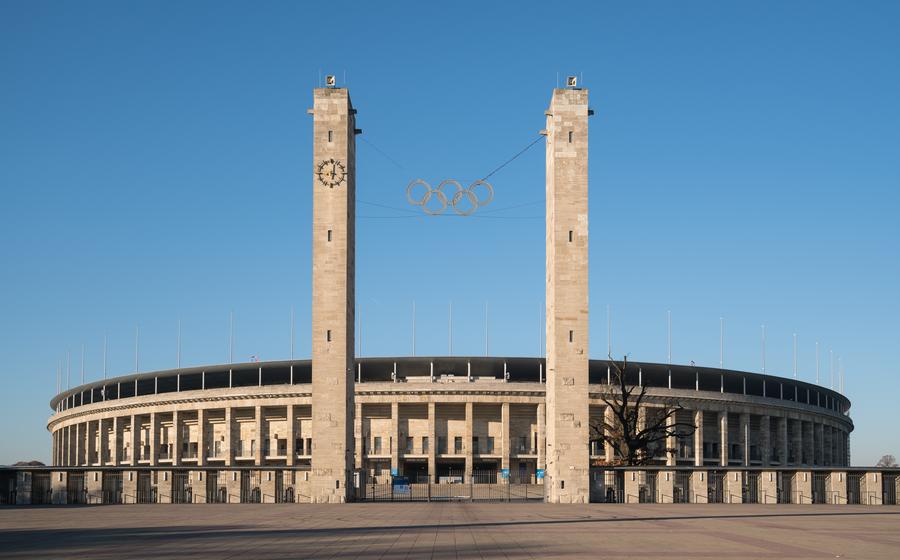
Olympic Stadium
- Historical Significance
- Architectural Features
- Sporting Events
- Guided Tours
- Museum
- Rooftop Terrace:
- Accessibility
- Food and Beverage Options
- Souvenir Shops
- Transportation
- Nearby Attractions
- Planning Your Visit
- Photography Tips:
- Virtual Tours:
Historical Significance
The Olympic Stadium in Berlin holds a significant place in German history, having served as the centerpiece of the 1936 Summer Olympics. Built under the Nazi regime, the stadium's architectural style embodies the monumental and imposing aesthetics favored by the National Socialists. Its horseshoe shape and iconic tower, designed by architect Werner March, represented the grandeur and power of the regime and were intended to showcase Germany's strength and prowess on the world stage. However, the stadium's legacy is also marred by its association with Nazi ideology and the dark chapter of German history. After the war, the stadium underwent extensive reconstruction and renovation, symbolizing Germany's efforts to move beyond its past and rebuild a more inclusive and peaceful society. Today, the Olympic Stadium stands as a reminder of both the triumphs and tragedies of Germany's past and serves as a venue for major sporting events and cultural gatherings.
Architectural Features
The Olympic Stadium stands as a testament to the architectural prowess of its time. Its striking horseshoe shape, reminiscent of a Greek amphitheater, creates an intimate and immersive atmosphere for spectators. The iconic tower, a symbol of strength and resilience, dominates the stadium's skyline, its height reaching towards the heavens. The use of reinforced concrete, a relatively new material at the time, allowed for the construction of a massive structure that could withstand the test of time. The stadium's clean lines, geometric forms, and minimalist aesthetic reflect the modernist architectural style prevalent in the 1930s. These architectural features not only contribute to the stadium's visual appeal but also hold historical significance, representing a chapter in German architectural history.
Sporting Events
The Olympic Stadium has played host to numerous legendary sporting events throughout its history. It served as the main venue for the 1936 Summer Olympics, leaving an indelible mark on the world of sports. Since then, it has continued to stage prestigious football matches, including matches of the German national team and the final of the DFB-Pokal, Germany's domestic cup competition. The stadium's rich football history is palpable, as it has witnessed iconic moments and memorable goals that have etched themselves into the annals of the sport.
In addition to football, the Olympic Stadium has hosted thrilling track and field competitions. The stadium's unique horseshoe shape creates an intimate and electrifying atmosphere for track and field events, making it a favorite among athletes and spectators alike. The stadium has seen world records broken and personal bests achieved, adding to its legacy as a hallowed ground for track and field enthusiasts.
Beyond sports, the stadium has also hosted a variety of concerts and music festivals, attracting renowned artists and bands from around the world. The stadium's vast capacity and state-of-the-art acoustics make it an ideal venue for large-scale musical events, providing an unforgettable experience for music lovers.
Whether it's football, track and field, or concerts, the Olympic Stadium guarantees an exhilarating and unforgettable experience for all attendees. The stadium's rich history, iconic status, and modern facilities make it a must-visit destination for sports fans and event enthusiasts alike.
Guided Tours
The Olympic Stadium offers guided tours that provide an immersive and informative experience for visitors. These tours are led by knowledgeable guides who share fascinating insights into the stadium's history, architecture, and significance. The tours typically cover the stadium's construction, its role in the 1936 Summer Olympics, its postwar reconstruction, and its current status as a multi-purpose sports and entertainment venue.
Visitors can choose from a variety of tour options, including standard guided tours, themed tours, and VIP tours. Standard guided tours typically last for about 90 minutes and cover the main highlights of the stadium, such as the grandstand, the running track, and the iconic tower. Themed tours, on the other hand, focus on specific aspects of the stadium's history or architecture, such as its Nazi past or its unique design features. VIP tours offer a more exclusive experience, with smaller group sizes and access to exclusive areas of the stadium.
Taking a guided tour of the Olympic Stadium is an excellent way to learn more about its fascinating history and architecture. The knowledgeable guides provide valuable insights and anecdotes that bring the stadium's story to life. Visitors can also explore areas of the stadium that are not accessible to the general public, such as the locker rooms and the press box.
To book a guided tour, visitors can either purchase tickets online or at the stadium's ticket office. It is advisable to book in advance, especially for popular tour times and dates. Guided tours are available in multiple languages, including English, German, and Spanish. Personal audio guides are also available for rent, offering a self-guided tour experience in a variety of languages.
Museum
The Olympic Stadium Museum, located within the stadium complex, offers a fascinating journey through the history of the stadium, sports, and the Olympic Games. Its exhibits take visitors on a chronological tour, showcasing the stadium's construction, its role in the 1936 Summer Olympics, its postwar reconstruction, and its transformation into a modern sports and entertainment venue.
Among the highlights of the museum are interactive displays that allow visitors to experience the thrill of running on the stadium's track or competing in a virtual cycling race. There are also exhibits dedicated to famous athletes who have competed at the stadium, as well as displays of Olympic torches, medals, and other memorabilia.
The museum also hosts temporary exhibitions on various sports-related topics, making it a dynamic and ever-changing space. Whether you're a sports enthusiast, a history buff, or simply curious about the Olympic Stadium, the museum is a must-visit destination.
Rooftop Terrace:
The Olympic Stadium's rooftop terrace offers a breathtaking panoramic vista of Berlin and its surroundings. Ascend to this elevated vantage point and let the city's iconic landmarks, including the Brandenburg Gate, the Reichstag, and the TV Tower, unfurl before your eyes. Capture stunning photographs of the cityscape, with the stadium's iconic silhouette serving as a majestic backdrop.
The terrace provides a unique perspective, allowing you to appreciate the stadium's grand scale and architectural details from above. On a clear day, the panorama extends far beyond the city limits, revealing glimpses of the surrounding countryside.
Due to safety considerations, access to the rooftop terrace may be restricted during certain events or weather conditions. Before your visit, check the stadium's website or inquire with a stadium representative to confirm accessibility.
Accessibility
The Olympic Stadium is committed to ensuring inclusivity and providing a welcoming environment for visitors with disabilities. Wheelchair ramps, elevators, and designated seating areas are available throughout the stadium, allowing for easy access and unobstructed views of events. Additionally, the stadium offers audio-descriptive tours and sign language interpreters for select events, catering to the needs of visually and hearing-impaired visitors. The staff at the stadium is well-trained and ready to assist visitors with any accessibility requirements, ensuring a comfortable and enjoyable experience for all.
Food and Beverage Options
The Olympic Stadium offers a wide range of food and beverage options to cater to the diverse tastes and preferences of visitors. From casual snacks to fine dining experiences, there's something for everyone to enjoy.
Inside the stadium, you'll find a variety of concession stands selling classic game-day fare such as hot dogs, hamburgers, and pretzels. For a more substantial meal, head to one of the stadium's restaurants, which offer a selection of international cuisine, including Italian, Asian, and German dishes.
If you're looking for a truly unique dining experience, book a table at the stadium's rooftop restaurant, which offers panoramic views of the city skyline while you savor delicious food and drinks.
No matter what your appetite or budget, you're sure to find something to satisfy your cravings at the Olympic Stadium. So come hungry and thirsty, and enjoy a culinary experience that's as memorable as the stadium itself.
Souvenir Shops
The Olympic Stadium boasts a range of souvenir shops that cater to every visitor's needs. These shops are a treasure trove of memorabilia, offering a wide selection of merchandise related to the stadium's history, sporting events, and the Olympic Games.
From classic stadium apparel and accessories to unique collectibles and gifts, there's something for every fan and enthusiast. Whether you're looking for a commemorative t-shirt, a replica jersey of your favorite team, or a special souvenir to remember your visit, you're sure to find it here.
Purchasing a souvenir from the Olympic Stadium is not just a way to commemorate your visit but also a way to support the stadium's preservation and ongoing legacy. By choosing to buy official merchandise, you're contributing to the maintenance and upkeep of this iconic landmark, ensuring that it continues to inspire and awe generations to come.
So, take advantage of the opportunity to visit the Olympic Stadium souvenir shops and bring home a piece of history. Whether you're a sports enthusiast, a history buff, or simply someone who appreciates unique and meaningful souvenirs, you'll find something special to cherish for years to come.
Transportation
Getting to the Olympic Stadium is a breeze, with multiple transportation options available. The stadium's convenient location near public transportation hubs makes it easily accessible by U-Bahn (subway), S-Bahn (urban rail), and buses. Simply hop on lines U2 or U9 and disembark at the Olympiastadion station, which is right outside the stadium gates. Alternatively, take S-Bahn lines S3, S5, S7, or S9 and alight at the Pichelsberg station, which is a short walk from the stadium. If you prefer to travel by bus, lines 104, 139, 218, and 310 will take you directly to the stadium.
For those arriving by car, the stadium offers ample parking facilities. The Olympic Stadium car park has over 1,000 parking spaces, including designated areas for disabled visitors. Parking fees apply, and it's advisable to pre-book your parking spot to secure a space, especially on event days.
Taxis and ride-sharing services are also readily available in Berlin, providing a convenient option for getting to and from the stadium. Simply hail a taxi on the street or use a ride-sharing app to request a ride. The stadium's prominent location ensures that drivers are familiar with the destination.
Whether you choose public transportation, a taxi, or a ride-sharing service, getting to the Olympic Stadium is hassle-free, allowing you to focus on enjoying your visit to this iconic sporting venue.
Nearby Attractions
In the vicinity of the Olympic Stadium, visitors are spoilt for choice with a myriad of captivating attractions that beckon exploration. A leisurely stroll or a short commute by public transport unveils a treasure trove of historical, cultural, and architectural wonders.
For those fascinated by history, the captivating Deutsches Historisches Museum stands as a testament to Germany's rich and complex past. Through its extensive collection of artifacts, visitors can delve deep into the nation's triumphs and tribulations, from the Holy Roman Empire to the reunification of Germany.
Art enthusiasts will find solace in the Gemäldegalerie, a haven for masterpieces from the 13th to the 18th centuries. Gaze upon the exquisite works of Dürer, Rembrandt, and Botticelli, and immerse yourself in the creative genius of bygone eras.
Nature lovers can seek respite in the tranquil embrace of the Tiergarten, Berlin's largest inner-city park. Stroll along its leafy paths, admire the shimmering lakes, and encounter an array of wildlife that calls this urban oasis home.
For a glimpse into contemporary culture, venture to the Sony Center, a vibrant complex that houses cinemas, restaurants, and the Filmhaus, a renowned arthouse cinema. Experience the latest cinematic offerings or delve into the fascinating world of photography at the C/O Berlin, a renowned photography gallery.
These attractions, among many others, await exploration, beckoning visitors to delve deeper into the rich tapestry of Berlin's past and present.
Planning Your Visit
To make the most of your visit to the Olympic Stadium, careful planning is essential. The best time to visit is during the summer months when the weather is pleasant, and the stadium is bustling with activity. To avoid crowds, consider visiting on a weekday morning or early afternoon. You can purchase tickets online or at the stadium's box office. If you're interested in learning more about the stadium's history and architecture, guided tours are available throughout the day.
Before your visit, check the stadium's website for any special events or exhibitions that may be taking place during your visit. To create a memorable experience, combine your visit to the stadium with other activities in Berlin, such as exploring the nearby Olympic Park, visiting the Brandenburg Gate, or taking a boat tour on the River Spree.
Remember to wear comfortable shoes as there's a lot of walking involved in exploring the stadium and its surroundings. Don't forget your camera to capture the stunning architecture and the vibrant atmosphere of the stadium. By following these tips, you'll have a fantastic and memorable visit to the Olympic Stadium in Berlin.
Photography Tips:
Capturing the grandeur of the Olympic Stadium through photography is a rewarding experience. Here are some tips to help you take stunning photos:
-
Best Angles: Experiment with different angles to find unique perspectives. Shoot from the base of the stadium to capture its towering height, or climb the steps for a bird's-eye view.
-
Lighting Conditions: The best time for photography is during the golden hours of sunrise and sunset when the warm light creates a magical glow. Night photography, with the stadium illuminated, offers a different kind of charm.
-
Composition Techniques: Use leading lines, such as the stadium's iconic tower or the rows of seats, to draw the viewer's eye into the photo. Incorporate elements of the surrounding landscape to create a sense of context.
-
Restrictions and Guidelines: Be aware of any photography restrictions or guidelines at the stadium. Some areas may be off-limits, or tripods may not be allowed.
-
Personal Experiences: I once captured a breathtaking shot of the stadium at sunset, with the sky ablaze in hues of orange and purple. The silhouette of the stadium against this vibrant backdrop was simply mesmerizing.
Virtual Tours:
For those unable to visit the Olympic Stadium in person, virtual tours offer an immersive and interactive way to experience its history, architecture, and atmosphere. These virtual tours allow you to navigate through the stadium's iconic spaces, including the grandstands, the running track, and the legendary tower, all from the comfort of your own home.
Enriched with historical information, multimedia content, and 360-degree views, these virtual tours provide a comprehensive and engaging experience. You can explore the stadium's exhibits, learn about its past events, and even get a bird's-eye view from the rooftop terrace.
To access the virtual tours, simply visit the Olympic Stadium's official website and follow the instructions. You'll need a stable internet connection and a modern web browser to enjoy the full experience.
Whether you're a history buff, a sports enthusiast, or simply curious about this iconic landmark, the virtual tours of the Olympic Stadium offer a unique and accessible way to explore its grandeur and significance.
